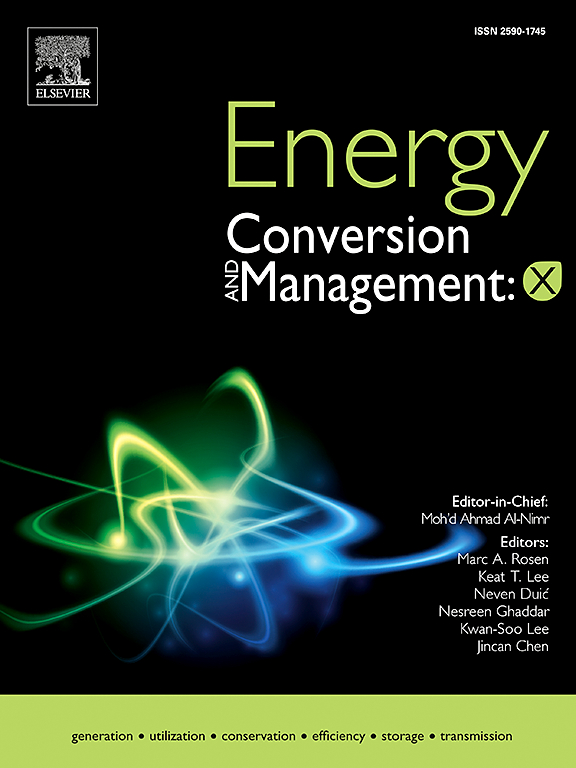Sustainable development and optimization of a geothermal–biomass hybrid energy system for green hydrogen production
IF 7.1
Q1 ENERGY & FUELS
引用次数: 0
Abstract
Fossil fuels remain the primary contributors to greenhouse gas emissions, particularly carbon dioxide. Transitioning toward renewable energy sources and adopting clean fuels, such as hydrogen, constitute effective strategies for mitigating CO2 emissions and decreasing global dependence on fossil-based energy systems. In this study, a carbon–neutral hybrid energy system was designed and developed to produce electricity, medium-pressure steam, hot water, and green hydrogen. The designed system utilizes municipal solid waste and geothermal energy as primary energy sources, offering an innovative solution for sustainable energy production. The proposed configuration integrates four principal subsystems: biomass steam gasification, a water electrolysis, a desalination unit, and a combined flash-binary geothermal system coupled with a cascaded organic Rankine cycle. A comprehensive evaluation was carried out, including thermodynamic analysis, sustainability assessment, environmental impact evaluation, and thermo-economic analysis. Furthermore, a detailed parametric study was conducted to assess the effects of key independent operating variables on the overall system performance. Subsequently, a multi-objective optimization was performed using the weighted sum method, aiming to minimize the TUCP and maximize the hydrogen production rate. The optimized system yielded useful outputs, including 230 kg/h of hydrogen, 31,217 kW of net electrical power, 18,488 kg/h of hot water, 1,981 kg/h of MP steam, and oxygen of 1054 kg/h. Thermodynamic analysis revealed an energetic efficiency of 78.57 % and an exergetic efficiency of 65.4 %, accompanied by a sustainability index of 2.89 and a TUCP of $3.70/GJ. The environmental assessment of the developed near-zero-carbon emission process highlighted substantial benefits, including an annual petroleum savings of 66,428 L/year and a reduction in annual CO2 emissions by 223,260 kg/year. Consequently, this study demonstrates an efficient, sustainable, and environmentally friendly process that effectively addresses energy and environmental challenges while outperforming comparable systems.

绿色制氢地热能-生物质混合能源系统的可持续发展与优化
化石燃料仍然是温室气体排放的主要来源,尤其是二氧化碳。向可再生能源过渡和采用氢等清洁燃料是减少二氧化碳排放和减少全球对化石能源系统依赖的有效战略。在本研究中,设计并开发了一种碳中性混合能源系统,可以产生电力、中压蒸汽、热水和绿色氢。设计的系统利用城市固体废物和地热能作为主要能源,为可持续能源生产提供了创新的解决方案。拟议的配置集成了四个主要子系统:生物质蒸汽气化,水电解,海水淡化装置,以及与级联有机朗肯循环相结合的闪蒸二元地热系统。进行了热力分析、可持续性评价、环境影响评价和热经济分析等综合评价。此外,还进行了详细的参数研究,以评估关键独立操作变量对整体系统性能的影响。随后,采用加权和法进行多目标优化,以TUCP最小、产氢率最大为目标。优化后的系统产生了有用的输出,包括230 kg/h的氢气,31,217 kW的净电力,18,488 kg/h的热水,1,981 kg/h的MP蒸汽和1054 kg/h的氧气。热力学分析结果显示,其能量效率为78.57%,火用效率为65.4%,可持续性指数为2.89,TUCP为3.70美元/GJ。对开发的接近零碳排放工艺的环境评估强调了巨大的效益,包括每年节省66,428升石油,每年减少223,260千克二氧化碳排放量。因此,本研究展示了一种高效、可持续、环保的工艺,有效地解决了能源和环境挑战,同时优于同类系统。
本文章由计算机程序翻译,如有差异,请以英文原文为准。
求助全文
约1分钟内获得全文
求助全文
来源期刊

Energy Conversion and Management-X
Multiple-
CiteScore
8.80
自引率
3.20%
发文量
180
审稿时长
58 days
期刊介绍:
Energy Conversion and Management: X is the open access extension of the reputable journal Energy Conversion and Management, serving as a platform for interdisciplinary research on a wide array of critical energy subjects. The journal is dedicated to publishing original contributions and in-depth technical review articles that present groundbreaking research on topics spanning energy generation, utilization, conversion, storage, transmission, conservation, management, and sustainability.
The scope of Energy Conversion and Management: X encompasses various forms of energy, including mechanical, thermal, nuclear, chemical, electromagnetic, magnetic, and electric energy. It addresses all known energy resources, highlighting both conventional sources like fossil fuels and nuclear power, as well as renewable resources such as solar, biomass, hydro, wind, geothermal, and ocean energy.
 求助内容:
求助内容: 应助结果提醒方式:
应助结果提醒方式:


